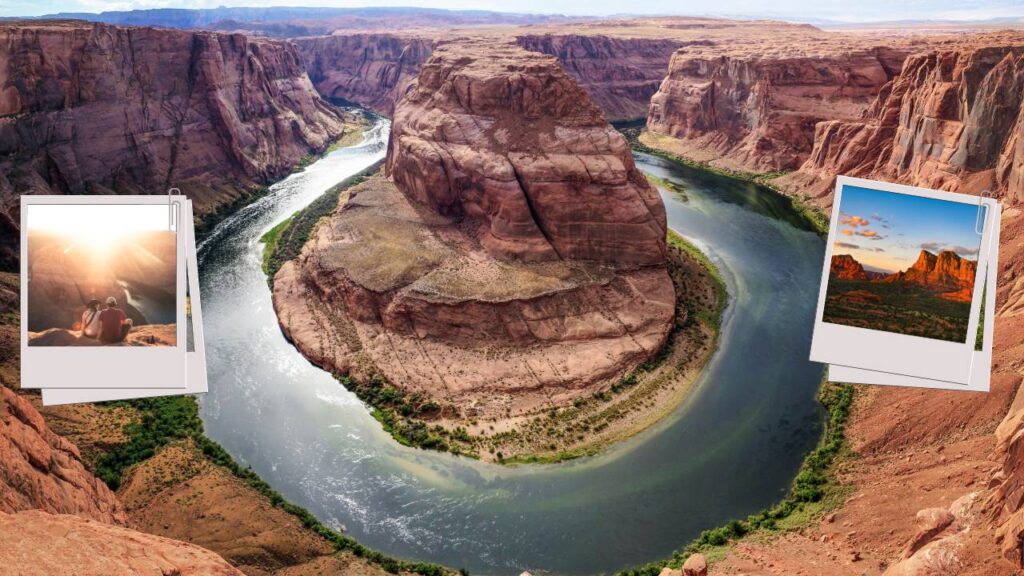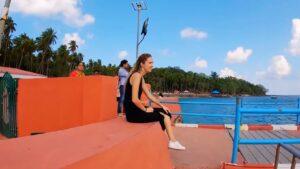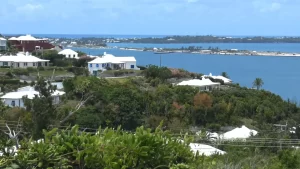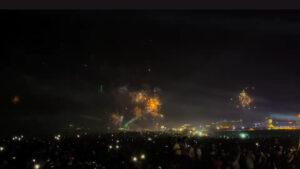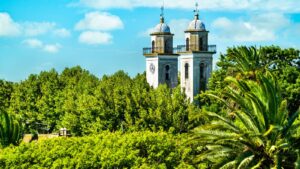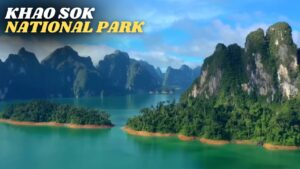Know Horseshoe Bend in Arizona exact location, how to get there, and the ideal times to witness its stunning natural beauty.
Located just outside the city of Page, Horseshoe Bend in Arizona stands as one of the most iconic and breathtaking viewpoints in the American Southwest. This dramatic natural curve of the Colorado River, shaped like a perfect horseshoe, has become a must-visit destination for travelers seeking awe-inspiring desert landscapes and unforgettable photo opportunities. Surrounded by towering sandstone cliffs and offering panoramic views of the river 1,000 feet below, Horseshoe Bend captivates visitors year-round with its unique geology and striking beauty.
Planning a scenic road trip, an outdoor adventure, or simply want to witness one of nature’s finest creations, understanding the location, how to get there, and the best time to visit Horseshoe Bend in Arizona will ensure a truly memorable experience.
Where is Horseshoe Bend Located in Arizona?
Horseshoe Bend is located in northern Arizona, just a few miles southwest of the town of Page in Coconino County. Specifically, it lies within the Glen Canyon National Recreation Area and is part of the greater Colorado Plateau region. The exact location of Horseshoe Bend is off U.S. Route 89, about 5 miles south of Page and roughly 140 miles northeast of Flagstaff, Arizona.
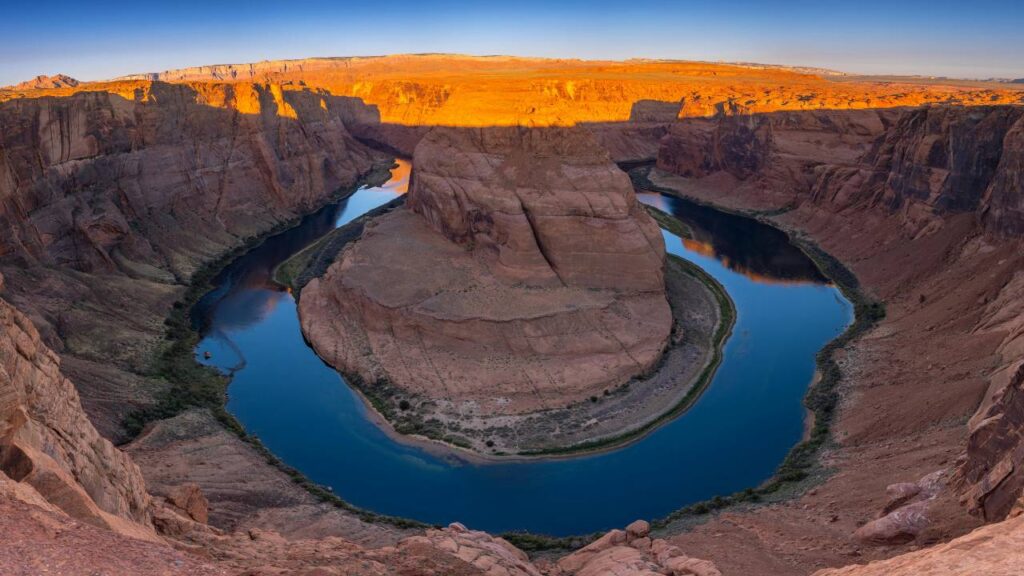
Though it’s not officially within Grand Canyon National Park, it offers similar awe-inspiring views of the Colorado River and is often visited along with Antelope Canyon, Lake Powell, and other nearby landmarks. Thanks to its accessibility and dramatic scenery, Horseshoe Bend in Arizona has become a popular spot for both amateur and professional photographers.
How to Get to Horseshoe Bend, Arizona – A Complete Guide
Reaching Horseshoe Bend, one of Arizona’s most iconic and photogenic landmarks, is relatively straightforward whether you’re traveling by car, RV, or with a guided tour. Situated just outside the town of Page, Arizona, this breathtaking viewpoint offers panoramic views of the Colorado River’s dramatic 270-degree curve, carved into the sandstone cliffs of Glen Canyon National Recreation Area.
Driving to Horseshoe Bend from Page, Arizona
Staying in Page, getting to Horseshoe Bend is a short and simple drive. Here’s how:
- Head south on U.S. Route 89 from the town center.
- After about 5 miles, you’ll see a clearly marked parking lot on the right-hand (west) side of the highway.
- This parking lot is the official trailhead to Horseshoe Bend.
Important Note: As of now, there’s a $10 per vehicle parking fee. No additional permit is required unless you’re visiting nearby areas like Antelope Canyon, which is on Navajo land.
Hiking to the Horseshoe Bend Viewpoint
Once you park, a moderate hike of approximately 0.75 miles (1.2 km) is required to reach the edge of the overlook. Here’s what you should expect:
- The trail is wide, sandy, and well-maintained, with minor elevation changes.
- The walk is suitable for most fitness levels, but temperatures can rise quickly in the desert sun.
- Expect minimal shade, so early morning or late afternoon hikes are ideal, both for comfort and for optimal photography lighting.
Hiking Tips:
- Wear sturdy walking shoes or hiking sandals.
- Carry at least one bottle of water per person.
- Use sunblock, sunglasses, and a wide-brimmed hat.
- Be cautious near the edge – while there are some safety railings, large parts of the cliff remain unprotected.
Once at the viewpoint, you’ll witness the jaw-dropping curve of the Colorado River, framed by steep red rock walls that plunge nearly 1,000 feet to the river below—making it a prime photo opportunity.
Directions from Major Cities
If coming from a larger city, here’s a breakdown of travel times and suggested routes to reach Horseshoe Bend:
From Flagstaff, Arizona:
- Distance: ~140 miles (225 km)
- Time: ~2.5 hours
- Route: Take US-89 North through Cameron, passing through scenic desert landscapes and Navajo Nation territory. Continue north until you reach the turnoff for Horseshoe Bend before entering Page.
From Phoenix, Arizona:
- Distance: ~270 miles (435 km)
- Time: ~4.5 to 5 hours
- Route: Start by heading north on I-17 to Flagstaff, then follow the US-89 North route. This route also provides access to other nearby attractions like Grand Canyon National Park (South Rim) and Wupatki National Monument if you want to make stops along the way.
From Las Vegas, Nevada:
- Distance: ~275 miles (443 km)
- Time: ~4.5 to 5 hours
- Route: Travel northeast on I-15, then take UT-9 East through Hurricane, UT, and follow US-89 South past Kanab, Utah, into Arizona. This route is quite scenic and also passes near Zion National Park.
Best Time to Visit Horseshoe Bend, Arizona: Complete Seasonal & Time-of-Day Travel Guide
Visiting Horseshoe Bend is an unforgettable experience, whether you’re a nature lover, an adventure traveler, or a professional photographer. However, knowing when to go is essential for getting the most out of your trip. While the site is open year-round and accessible every day, the time of year and time of day you choose to visit can dramatically influence the views, comfort level, and crowd density you’ll encounter.
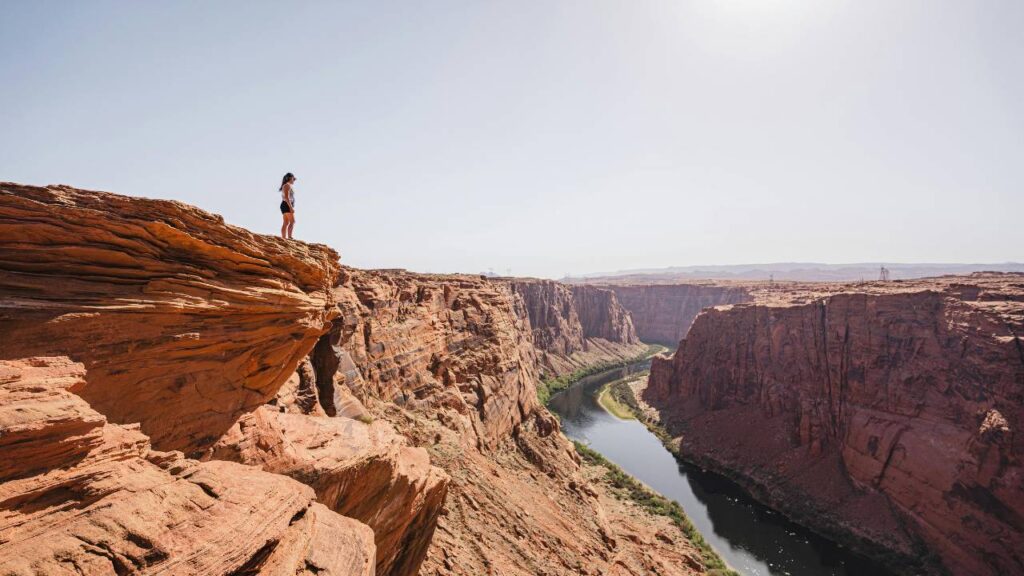
Let’s dive deep into how each season shapes the Horseshoe Bend experience and why timing your visit properly can transform an ordinary trip into an extraordinary one.
Spring (March to May) – A Season of Comfortable Weather and Blooming Views
Spring is often regarded as the sweet spot for visiting Horseshoe Bend. During this time, the desert landscape begins to awaken after winter, offering a colorful palette of blooming wildflowers, cacti, and greenery. The weather is relatively mild, with daytime temperatures ranging from the low 60s to upper 80s Fahrenheit (15°C to 31°C). This makes hiking the 0.75-mile trail to the overlook far more enjoyable compared to the scorching heat of summer.
In addition to pleasant weather, spring is also an excellent time for landscape photography. The angle of the sunlight during sunrise and sunset produces soft golden tones, creating stunning contrasts on the red cliffs and the Colorado River below. Mornings tend to be peaceful, especially on weekdays, offering a serene atmosphere to soak in the views without large crowds.
That said, spring break and Easter holidays may draw in more visitors, so planning your visit outside peak vacation windows or arriving early in the day can help you enjoy a quieter experience.
Summer (June to August) – Bright Light, Longer Days, and Intense Heat
Summer is the most popular time to visit Horseshoe Bend, primarily due to school vacations and the increased number of road trippers passing through Arizona. However, it’s also the hottest time of year, with daytime temperatures frequently surpassing 100°F (38°C). This can make the hike from the parking lot to the viewpoint exhausting and potentially unsafe if you’re not properly prepared.
Because the desert heat is so intense, it’s strongly recommended to visit during the early morning hours just after sunrise or later in the evening around sunset. These time windows offer significantly cooler temperatures and more dynamic lighting conditions. The sun at these times is low on the horizon, casting long shadows and enhancing the textures and depth of the canyon walls.
The summer months also bring monsoon season (typically in July and August), which can lead to sudden thunderstorms. While these storms can create dramatic skies for photos, they also bring safety risks due to lightning and flash flooding. Always check the forecast before setting out and avoid visiting during storm warnings.
Fall (September to November) – Golden Season of Balance and Beauty
Fall is considered by many experienced travelers and photographers to be the ideal season for visiting Horseshoe Bend. The weather begins to cool, with daytime highs dropping to a more manageable 70°F to 85°F (21°C to 29°C). The summer crowds also start to dissipate, especially after Labor Day, making the overall experience more relaxing and enjoyable.
This season offers some of the best lighting conditions for photography. The air is often clearer due to reduced atmospheric haze, resulting in crisper images. The position of the sun during autumn favors both sunrise and sunset photography, especially in October when the golden hour light bathes the cliffs in rich amber tones.
Because temperatures in the evening can drop quickly, especially by November, it’s wise to bring a light jacket or extra layers. Visiting during the week instead of weekends can also ensure a more peaceful and undisturbed experience.
Winter (December to February) – Quiet Beauty and Unique Photo Opportunities
Winter provides a completely different perspective of Horseshoe Bend. While the desert is quieter and colder during this time, it rewards travelers with solitude, sharp light contrasts, and occasional snow-capped scenery. Temperatures often range from 30°F to 50°F (-1°C to 10°C) during the day, with even colder mornings and evenings.
If someone who prefers avoiding crowds and doesn’t mind bundling up, winter is perfect. The early sunrise and early sunset times mean you can catch both golden hours without having to wake up extremely early or stay out late. The low angle of the winter sun also adds depth and dimension to your photos, often creating dramatic shadows that emphasize the bend’s structure.
While snow is uncommon in Page, it does occasionally occur—and when it does, the contrast of white snow on red rock can create a visually stunning and rare photo opportunity.
The biggest downside is the short daylight hours, which give you less time to visit the area. You’ll need to plan efficiently and check sunrise and sunset times in advance.
Best Time of Day for Photography – Timing is Everything
Regardless of the season, the time of day is a major factor in capturing Horseshoe Bend’s beauty at its fullest. The sun’s position greatly affects how light and shadow fall across the canyon walls and river.
Midday (10 AM – 2 PM)
During this time, the sun is directly overhead. This is when the entire curve of Horseshoe Bend is evenly lit, minimizing shadows inside the canyon. If you’re looking to capture the full horseshoe shape clearly from top to bottom, midday is ideal. However, the light may be harsh, especially in summer, so filters or post-processing may be needed.
Sunrise (Approximately 6 AM – 7:30 AM)
Sunrise at Horseshoe Bend is magical, with cooler hues and fewer visitors. The light is soft and pastel-like, and you may see a beautiful glow on the eastern cliffs. This is a peaceful time for introspective travelers and those wanting to avoid the hustle of midday tourists.
Sunset (Approximately 5 PM – 6:30 PM, depending on season)
This is the most popular time for photographers and for good reason. As the sun lowers in the west, it bathes the landscape in golden and orange tones. The curves and layers of the canyon become more pronounced, and the view transforms dramatically minute by minute. It can be crowded, so arriving an hour early is recommended to claim a good spot.
Things to Do Near Horseshoe Bend, Arizona: A Complete Guide to Nearby Attractions & Activities
While the mesmerizing view from Horseshoe Bend is the main draw for many visitors, the surrounding area offers a wealth of natural wonders, cultural experiences, and outdoor adventures. Located just outside the small town of Page, Arizona, Horseshoe Bend is perfectly situated to serve as your base for a full day or even a long weekend of exploration.
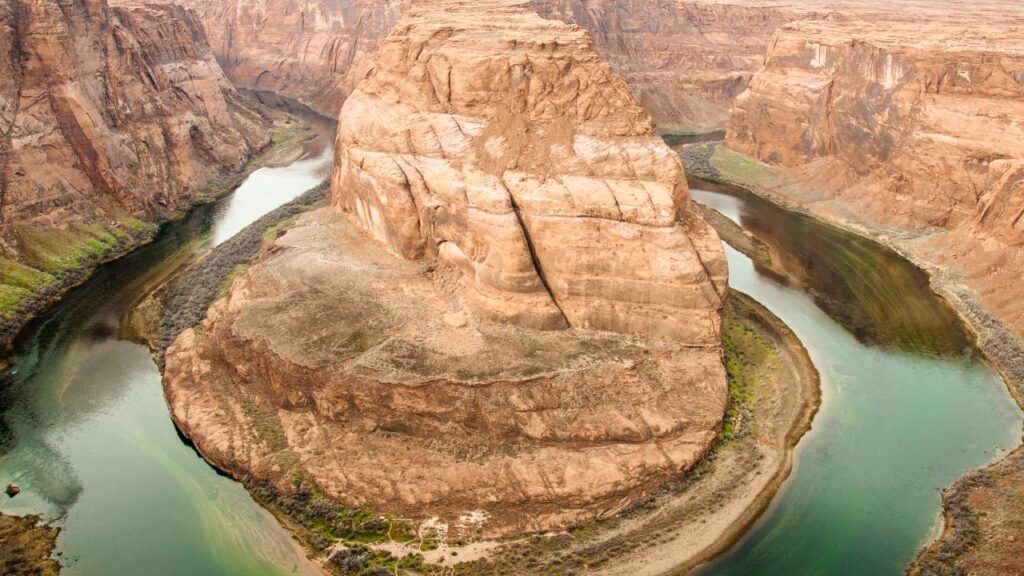
Here’s a comprehensive breakdown of nearby must-visit destinations and activities—each offering a unique perspective of the American Southwest.
1. Antelope Canyon – A Surreal Slot Canyon Just Minutes Away
Distance from Horseshoe Bend: Approx. 10 minutes by car
Experience Type: Guided Tour (Required)
If there’s one place you simply cannot miss after Horseshoe Bend, it’s Antelope Canyon—an awe-inspiring slot canyon located just east of Page. Famous for its narrow sandstone corridors, smooth wave-like walls, and the ethereal light beams that pierce through cracks overhead, Antelope Canyon is a dream location for photographers and nature lovers alike.
Antelope Canyon is divided into two primary sections: Upper Antelope Canyon and Lower Antelope Canyon.
- Upper Canyon is the more famous of the two, particularly for its light beams during mid-day (best between 10 AM and 12 PM from late March to early October). It has easier ground-level access, which makes it more suitable for all ages.
- Lower Canyon is longer and more physically demanding, requiring visitors to navigate stairs and narrow passageways, but it tends to be less crowded and equally stunning.
2. Lake Powell & Glen Canyon Dam – Water Recreation Meets Natural Engineering
Distance from Horseshoe Bend: Approx. 10–15 minutes by car
Experience Type: Self-guided or guided tours, outdoor activities
Located just a short drive north of Page, Lake Powell is one of the largest man-made reservoirs in the United States, stretching across the Arizona–Utah border. Formed by the Glen Canyon Dam on the Colorado River, this reservoir is more than just a water source—it’s a recreational playground surrounded by red rock canyons and turquoise waters.
Visitors can enjoy a variety of activities on the lake:
- Boating and kayaking: Visiting hidden coves and towering cliffs from the water.
- Paddleboarding: Rent equipment and glide across glassy waters during early morning hours.
- Jet-skiing and house boating: Popular choices for multi-day family trips or adventurous weekends.
Just next to Lake Powell, the Glen Canyon Dam Visitor Center offers guided tours that delve into the hydrological, geological, and historical significance of the dam and the broader Glen Canyon region. From the overlook, you’ll see the Colorado River flow downstream toward Horseshoe Bend.
3. Navajo Village Heritage Center – Cultural Discovery in Page, AZ
Distance from Horseshoe Bend: Approx. 5–10 minutes by car
Experience Type: Educational, cultural, guided
Those looking to gain deeper insight into the region’s Native American heritage, the Navajo Village Heritage Center in Page is a must-visit. This cultural center is a living museum that showcases authentic Navajo dwellings, traditions, storytelling, and performances.
Visitors can experience:
- Traditional Navajo homes (hogan) and structures
- Live cultural demonstrations, such as rug weaving, fire making, and sand painting
- Dance performances, including the dramatic hoop dance
- Interactive learning, making it a great educational stop for children and families
This is a perfect way to connect with the indigenous history of the land you’re exploring and support the local Navajo community through sustainable tourism.
4. Vermilion Cliffs National Monument – A Remote Wonderland of Color & Texture
Distance from Horseshoe Bend: Approx. 1.5 to 2 hours by car
Experience Type: Hiking, photography, off-road exploration
If willing to venture a bit further off the beaten path, Vermilion Cliffs National Monument is one of the most visually striking landscapes in the American Southwest. Known for its striking rock formations, colorful layered cliffs, and remote beauty, this protected area offers several iconic sites:
- The Wave: A surreal, undulating rock formation famous among photographers. Access is limited to 20 permits per day via a lottery system due to its fragile environment.
- White Pocket: A great alternative to The Wave that doesn’t require permits but does require a high-clearance 4WD vehicle.
- Buckskin Gulch: One of the longest slot canyons in the world, perfect for more seasoned hikers who want a challenge.
This area is remote, so be prepared with plenty of water, navigation tools, and a full tank of gas. Because of the rough terrain, many travelers opt to book 4×4 tours or go with experienced local guides.
5. Colorado River Rafting – A Peaceful Float Through Towering Canyon Walls
Distance from Horseshoe Bend: Begins at Glen Canyon Dam, 10–15 minutes away
Experience Type: Half-day or full-day guided excursion
To experience the dramatic canyon walls of Horseshoe Bend and the Colorado River from an entirely different perspective, consider booking a smooth-water rafting trip. Unlike the adrenaline-pumping white-water rafting farther down the Colorado, these trips are calm, scenic, and beginner-friendly, making them suitable for all ages.
Trips typically begin below Glen Canyon Dam and float downriver through towering canyon walls, meandering through the base of Horseshoe Bend, and ending at Lees Ferry. Along the way, experienced guides share geological facts, cultural stories, and local wildlife sightings.
Rafting tours offer a tranquil way to see the canyon’s grandeur up close, without the hiking crowds above, and are especially magical in the early morning when the river reflects the warm canyon colors.
Horseshoe Bend Arizona Travel Tips: Plan Your Visit Like a Pro
When you visit Horseshoe Bend, Arizona, you’ll experience one of the most stunning natural wonders in the American Southwest. But to make the most of your trip, you need more than just a camera—you need a solid plan. I’ve put together everything you should know to stay safe, comfortable, and well-prepared during your visit. Let’s break it down by what you’ll actually do—from parking your car to snapping the perfect photo.
1. Park Smart and Know the Entry Rules
You’ll park in the official Horseshoe Bend parking lot, which sits just off U.S. Route 89, about five miles south of downtown Page, Arizona. The City of Page manages the parking lot, so don’t expect your National Parks Pass or America the Beautiful Pass to work here—they don’t.
Instead, pay a flat $10 fee per vehicle, and the lot attendants will direct you where to park. If you’re driving an RV or a large vehicle, you’ll pay a little more, but the lot provides space for oversized vehicles too.
Parking fills up fast during midday, especially in peak months like March through October. Arrive before 9 AM or after 4 PM to avoid the crowds and the hot sun.
2. Stay Safe at the Edge
When you reach the main overlook, you’ll stand over 1,000 feet above the Colorado River. The view stuns nearly every visitor—but it’s also risky if you’re not cautious.
The overlook has no guardrails along most of the cliff, and the wind can hit hard without warning. Stay a few feet back from the edge, especially if you’re holding a camera, phone, or small child.
Keep your children and pets close, and always stay aware of your footing. The rock near the edge can crack or crumble. You don’t want to take a wrong step for the sake of a photo.
Wear shoes with good grip, especially if you visit early in the day when the ground may be damp or frosty.
3. Choose the Best Time to Go
The best time to visit Horseshoe Bend depends on your goals:
If you want peace and quiet, arrive at sunrise. The soft light creates beautiful shadows, the weather stays cool, and you’ll beat the crowds.
If chasing golden-hour photos, go in the late afternoon, around 5 PM to 6 PM. That’s when the sun lights up the red rocks and gives the canyon its iconic glow. Just be ready for company—the overlook gets busy in the evenings.
Avoid the midday hours (11 AM to 3 PM), especially in summer. You’ll face the harshest sun, the hottest temperatures, and the biggest crowds.
4. Prepare for the Desert Climate
Horseshoe Bend sits in the high desert, so the weather changes fast and the sun shows no mercy. Prepare ahead and dress for the environment.
Always bring at least one bottle of water per person, especially in warmer months. You’ll walk about 1.5 miles round trip from the parking lot, and the trail has zero shade.
Wear a wide-brimmed hat, sunglasses, and sunscreen, even on cooler days. The desert sun reflects off the sand and rocks and can cause sunburn faster than you’d expect.
During the colder months, dress in layers. Mornings can feel icy, but the sun warms things up quickly by noon. And in summer, avoid hiking between 12 PM and 4 PM when the heat peaks.
Watch for monsoon storms in July and August. If rain starts, return to the parking area immediately—flash floods can hit the desert floor fast.
5. Understand Accessibility Options
While Horseshoe Bend tries to accommodate all visitors, the main trail doesn’t fully meet wheelchair-accessible standards. It consists of packed sand and some gravel inclines.
Find an accessible paved viewing platform just a short walk from the parking lot. If you or someone in your group has mobility limitations, this platform provides a safer, easier option to view the canyon—without completing the full hike.
The trail also includes rest benches along the path, so you can take breaks if needed.
6. Capture the Best Photos Without a Drone
Horseshoe Bend is a photographer’s dream—but the wide curve of the river makes it tricky to fit in one frame. Bring a wide-angle or ultra-wide lens to capture the full bend from the main overlook.
If you want sharp, colorful shots, plan your visit during the early morning or golden hour. Midday light tends to flatten the landscape and wash out colors.
Use a tripod if you’re serious about image quality, and experiment with panoramic shots or HDR settings on your camera or phone.
Leave your drone at home. Horseshoe Bend lies inside the Glen Canyon National Recreation Area, and the FAA prohibits drones here. Park rangers enforce this rule, and fines can exceed $1,000.
7. Find a Place to Stay in Page, Arizona
You’ll want to stay overnight if you plan to visit multiple attractions like Antelope Canyon, Lake Powell, or Glen Canyon Dam. Luckily, Page offers a wide range of accommodations for different budgets.
Book a mid-range hotel like Hampton Inn, Best Western View of Lake Powell, or Hyatt Place for comfort and convenience. These hotels often include breakfast and pool access—ideal after a hot hike.
If you prefer budget travel, consider local motels and independent lodges. They offer clean rooms and good service at lower rates.
Also find several RV parks and campgrounds around Page if you’re traveling by camper or want to sleep under the stars. Some campgrounds near Lake Powell provide stunning views of the desert and direct access to outdoor adventures.
Make sure to book in advance during peak season, especially from March through October, when tour buses, families, and international travelers fill up the town.
FAQs
1. What is Horseshoe Bend in Arizona?
Horseshoe Bend is a stunning natural rock formation where the Colorado River makes a 1,500-foot-long curve, creating a horseshoe shape. It’s located just outside of Page, Arizona, within the Glen Canyon National Recreation Area.
2. How do I get to Horseshoe Bend in Arizona?
To reach Horseshoe Bend, drive about 5 miles south of Page on U.S. Route 89. Park in the designated lot and hike a 0.75-mile trail to the viewpoint.
3. Is there an entrance fee to visit Horseshoe Bend?
Yes, there is a fee to park at the official lot near the viewpoint. As of now, the fee is $10 per vehicle, and cash or credit cards are accepted.
4. What is the best time to visit Horseshoe Bend in Arizona?
The best times to visit are early morning or late afternoon, especially during spring or fall, to avoid crowds and enjoy the best lighting for photos.
5. Is the hike to Horseshoe Bend difficult?
The hike to Horseshoe Bend is easy and mostly flat, covering just 0.75 miles one way. It takes about 20-30 minutes to reach the viewpoint, making it accessible for most visitors.
6. Can I visit Horseshoe Bend year-round?
Yes, Horseshoe Bend is open year-round. However, temperatures can get extremely hot in the summer, so it’s best to visit during cooler months or early morning/late evening during the summer.
7. Is it safe to visit Horseshoe Bend with children?
While Horseshoe Bend is a family-friendly destination, be cautious near the cliff’s edge. There are no guardrails, and the drop is significant, so always supervise children closely.
8. Are there any nearby attractions to Horseshoe Bend?
Yes, nearby attractions include Antelope Canyon, Lake Powell, the Glen Canyon Dam, and several scenic viewpoints around the Glen Canyon National Recreation Area.
9. Can I bring pets to Horseshoe Bend?
Pets are allowed at Horseshoe Bend, but they must be kept on a leash at all times. Be sure to bring water for your pet, especially during the hot summer months.
10. Are there accommodations near Horseshoe Bend in Arizona?
Yes, there are several hotels, motels, and campgrounds in Page, Arizona, which is just a short drive away. You can also find RV parks and vacation rentals in the area.
